I have a Pandas DataFrame of measurements:
,Fp076,Fp084,Fp092,Fp099,Fp107,Fp115,Fp122,Fp130,Fp143,Fp151,Fp158,Fp166,Fp174,Fp181,Fp189,Fp197,Fp204,Fp212,Fp220,Fp227
0,0.531743,0.512256,0.427771,0.444216,0.332228,0.296139,0.202653,0.298724,0.341529,0.276829,0.24803,0.278406,0.345853,0.317384,0.32032,0.179936,0.205871,0.495948,0.167417,0.097147
1,-0.032964,0.047469,0.128079,0.142839,0.253755,0.165963,0.210111,0.239816,0.162333,0.115085,0.129781,0.134795,0.09575,0.243093,0.10684,0.195201,0.143984,0.266312,0.198049,0.084467
2,0.459728,0.541346,0.830889,0.368135,0.407241,0.499617,0.383159,0.507517,0.409411,0.325441,0.305605,0.378738,0.342981,0.43766,0.295844,0.228164,0.276319,0.226467,0.375678,0.219189
3,2.6838,2.394591,2.493416,0.874906,2.113343,1.812258,1.667047,1.779347,1.515663,1.620196,1.539494,1.63528,1.555373,1.471318,1.610067,1.507087,1.467174,1.458346,1.681998,1.14625
4,0.368415,0.435004,0.155035,0.161064,0.180133,0.202117,0.142981,0.138321,0.122557,0.099213,0.098213,0.062174,0.123664,0.2051,0.167415,0.185133,0.127677,0.037875,0.156252,0.015579
5,0.213577,0.187244,0.274151,0.173572,0.296122,0.308341,0.164578,0.159559,0.318383,0.181329,0.260223,0.257395,0.241779,0.292731,0.244476,0.187523,0.247331,0.293338,0.323894,0.179478
6,0.096093,0.140454,0.067185,6.441058,0.016797,0.141757,0.181792,0.13692,0.204091,0.180182,0.149626,0.220342,0.179286,0.276316,0.104531,0.20343,0.045161,-0.004546,0.045833,0.193849
7,0.286467,0.086673,-0.106538,-0.261802,0.16964,0.182858,0.062774,0.20471,0.040105,0.086975,0.211068,0.182423,0.098721,0.077085,0.102986,0.129935,0.130571,0.176024,0.154079,0.102391
8,0.480631,0.714554,0.858241,0.746666,0.555411,0.452689,0.337912,0.333942,0.269359,0.221312,0.09818,0.226218,0.287361,0.209858,0.222951,0.207584,0.258397,0.026713,0.162048,0.149924
9,1.055405,0.638777,0.468793,0.41544,0.559187,0.471218,0.493805,0.544716,0.412903,0.412182,0.51041,0.383991,0.351397,0.383201,0.368308,0.237954,0.330242,0.262648,0.425204,0.434928
10,1.116658,0.737544,0.854376,-0.004434,0.419419,0.35921,0.377095,0.273815,0.258913,0.290614,0.271843,0.321572,0.234764,0.298931,0.206039,0.192746,0.200727,0.132419,0.229914,0.159857
11,-0.004305,0.052289,0.275035,-0.849414,0.104146,0.185819,0.128376,0.136433,0.091787,0.149753,0.107246,0.081407,0.118816,0.117434,0.169153,0.108273,0.205751,0.145238,0.153086,0.114278
12,0.836223,0.323901,0.269564,0.364082,0.343695,0.386785,0.24881,0.307267,0.222634,0.214189,0.12167,0.251107,0.134083,0.284545,0.175479,0.221877,0.184749,0.225089,0.205388,0.214972
where each row is the flux measurements at the frequencies in the header (76, 84, 92, 99... MHz). I'm trying to plot a line graph of the flux measurements for a row. Since the frequencies in the header are not linear, I've tried this:
f = np.array([76,84,92,99,107,115,122,130,143,151,158,166,174,181,189,197,204,212,220,227])
y1 = [0.531743,0.512256,0.427771,0.444216,0.332228,0.296139,0.202653,0.298724,0.341529,0.276829,0.24803,0.278406,0.345853,0.317384,0.32032,0.179936,0.205871,0.495948,0.167417,0.097147]
y2 = [-0.032964,0.047469,0.128079,0.142839,0.253755,0.165963,0.210111,0.239816,0.162333,0.115085,0.129781,0.134795,0.09575,0.243093,0.10684,0.195201,0.143984,0.266312,0.198049,0.084467]
y3 = [0.459728,0.541346,0.830889,0.368135,0.407241,0.499617,0.383159,0.507517,0.409411,0.325441,0.305605,0.378738,0.342981,0.43766,0.295844,0.228164,0.276319,0.226467,0.375678,0.219189]
fig, ax = plt.subplots()
ax.scatter(f, y1, label = r'$\alpha = -0.37$')
ax.plot(f, y1)
ax.scatter(f, y2, label = r'$\alpha = NaN$')
ax.plot(f, y2)
ax.scatter(f, y3, label = r'$\alpha = -0.75$')
ax.plot(f, y3)
ax.set_xlabel('Frequency (MHz)')
ax.set_ylabel('Flux (Jy/beam)')
ax.grid(which = 'both', axis = 'both')
which is just copy-pasting the first three rows of data, to produce:
That's basically what I want, but what's a better way to do it?


